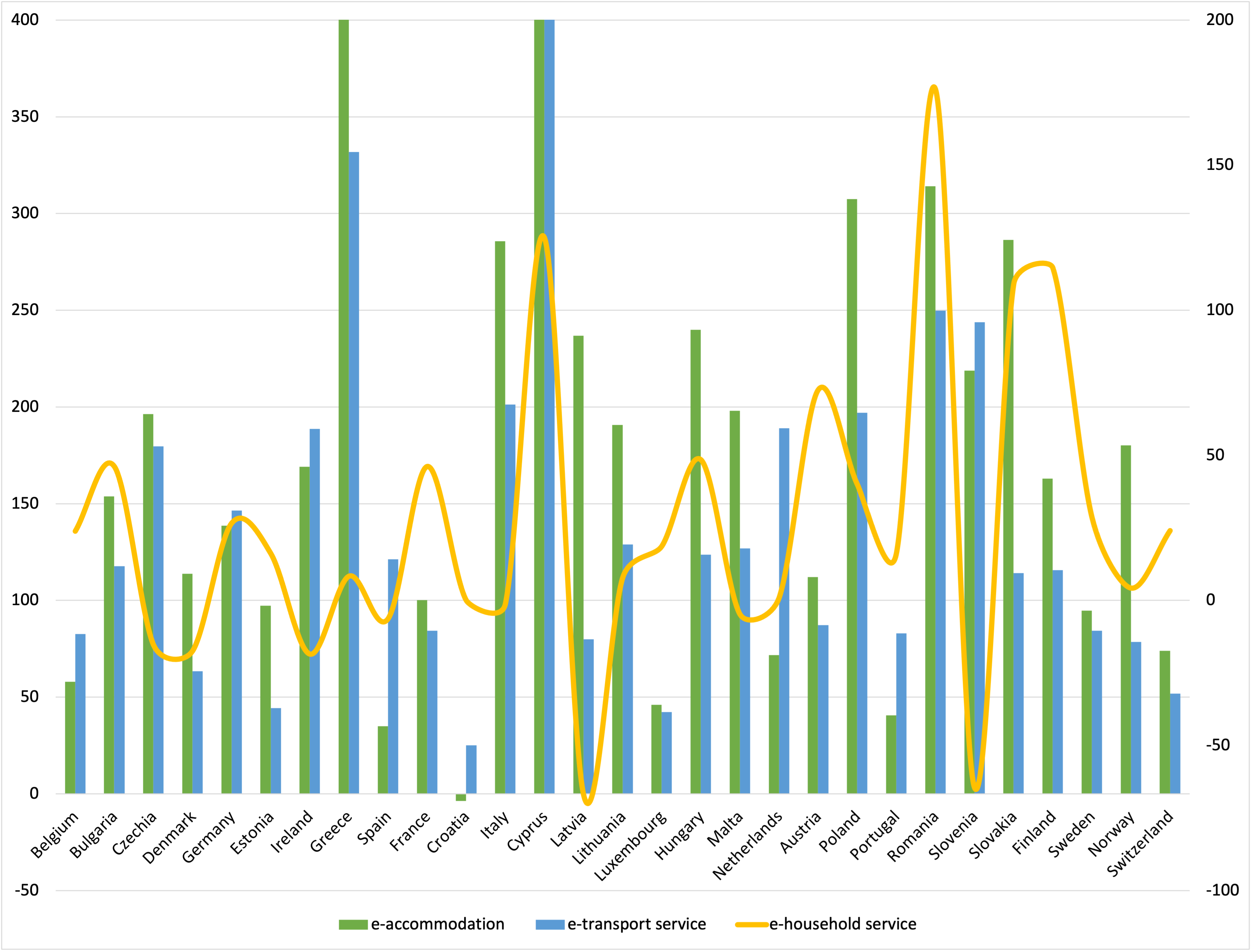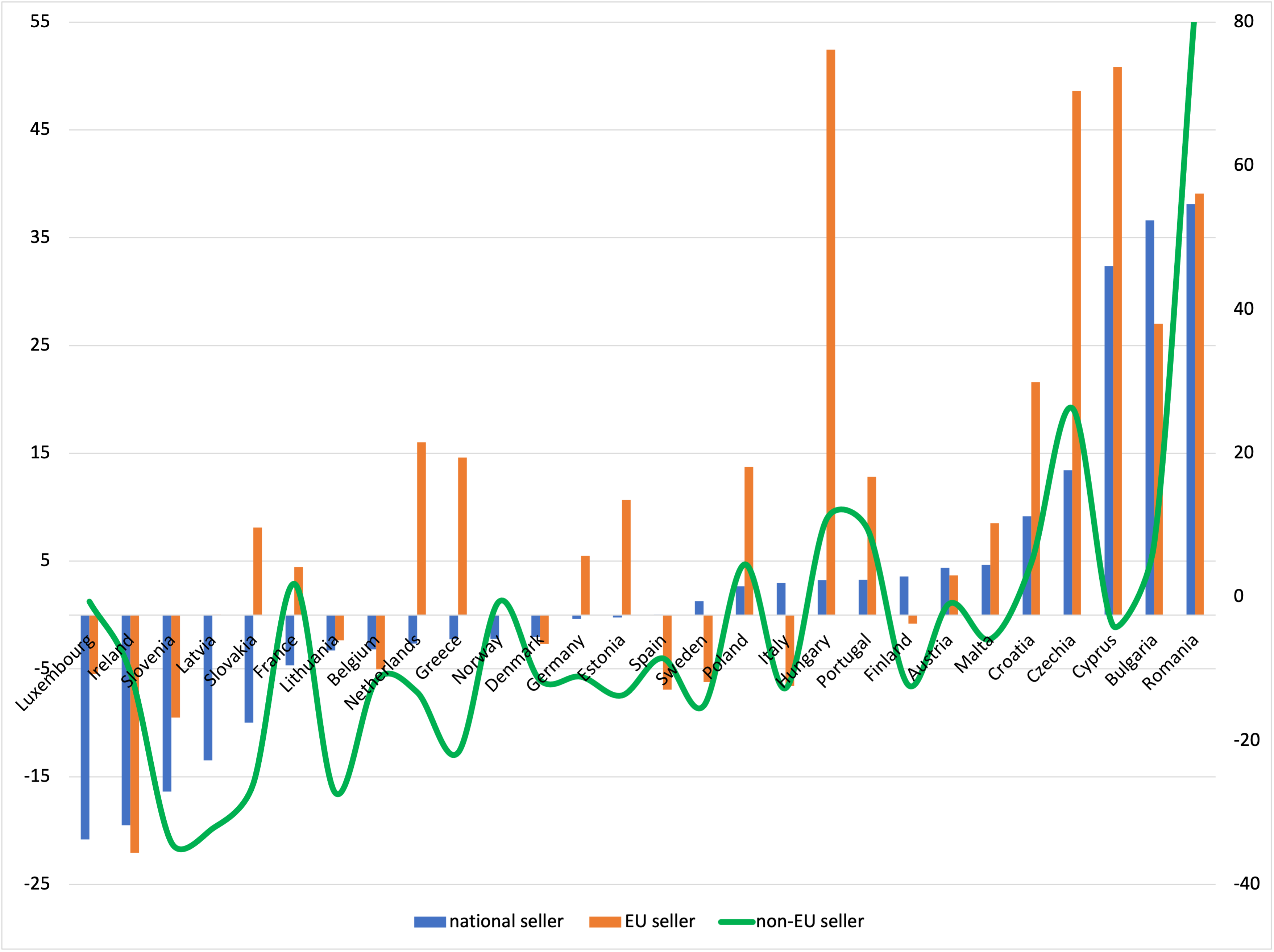Overviews
Author: Natalia Grishchenko
May 5 2024
E-commerce trends in the EU
The dynamics of e-commerce as part of the EU economy demonstrates new trends that are of interest to entrepreneurs and companies. What types of online purchases were popular in the EU in 2021–2023? What kind of e-commerce dynamics are countries demonstrating? The answers to these and other questions in our overview.
Online purchases by individuals have seen varied changes across different countries between 2020 and 2023 (Fig. 1). The most significant growth in e-commerce was noted in Cyprus with around 20%, followed by Slovakia at roughly 18%, and Serbia and Ireland both at approximately 17%. Most countries experienced moderate growth, ranging from 2% to 7%, while Germany experienced a decline of 8%.

Fig. 1. Online purchases in the EU, % of individuals, 2020, 2023.
Source: Eurostat (2024).
The dynamics of online shopping vary depending on the product category. Trends in online purchases of traditional physical goods reveal mixed outcomes (Fig. 2). Most countries have experienced a decline in book sales, except for Bulgaria, which saw a 57% increase, and the Czech Republic, with a 17% rise. In the clothing category, approximately one-third of the countries exhibited positive trends, such as Cyprus with 53%, Romania 48%, and Bulgaria with 41%. Meanwhile, the middle third of countries showed either moderate growth or stability, as seen in Belgium, the Czech Republic, and Greece. The final third of countries reported negative trends, including Ireland with a 19% decrease, Latvia 16%, and Slovenia with 11%. Similarly, trends in online computer sales mirrored this pattern, with significant growth in Bulgaria (41%) and Hungary (36%), but substantial declines in Latvia (46%) and Slovenia (44%). In contrast, most countries experienced growth in the online retail of cosmetics and medicine, with the exception of Greece, Croatia, and Slovenia. The largest increases were observed in Bulgaria (171%), Cyprus (72%) and the Czech Republic (60%). Regarding online sport goods, Croatia led with a 117% growth, followed by Hungary at 60% and Cyprus at 51%.

Fig. 2. Changes in online purchases of selected goods in physical form, the EU, %, 2021–2023.
Source: Eurostat (2024).
Most countries are experiencing growth in e-services, particularly in e-accommodation (Fig. 3). Countries like Greece, Cyprus, and Romania have seen remarkable increases of 300–400%. E-transport services generally show a positive trend, while e-household services exhibit both increases and decreases from 2021 to 2023, varying by country. The largest declines were recorded in Latvia with 67% and Slovenia with 65%.

Fig. 3. Changes in online purchases by type of electronic services, the EU, %, 2021–2023.
Source: Eurostat (2024).
There is a general categorization of countries into three groups bases on the dynamics of online sales for software, applications and games (Fig. 4). The first group, which includes Ireland, Croatia, Latvia, Sweden, and Cyprus, is experiencing declines across all types of software and applications. However, online sales of applications for study, travel, and weather have seen overall growth, ranging from 1.4% in Germany to approximately 114 % in Bulgaria and the Czech Republic. Electronic health apps display mixed trends, similar to those observed in computer software. Meanwhile, the dynamics of online game purchases from 2021 to 2023 indicate a decline in Cyprus (63%), Latvia (45%), Sweden (36%), Slovenia (28%) and Italy (23%). Conversely, there have been significant increases in the Czech Republic (98%), Hungary (60%), and Romania (54%).

Fig. 4. Сhanges in online purchases of e-apps, the EU, %, 2021–2023.
Source: Eurostat (2024).
A similar pattern in e-commerce is evident when looking at online shopping based on the origin of the seller: national, EU, and non-EU (Fig. 5). While the trends in e-commerce from national and EU sellers vary by country, overall, there has been a general increase in online purchases from national sellers and a decrease in purchases from non-EU sellers between 2021 and 2023.

Fig. 5. Changes in online purchases by origin of seller, the EU, %, 2021–2023.
Source: Eurostat (2024).
In terms of e-commerce for financial services, there has been a nearly universal increase in the sales of insurance policies, including travel insurance (Fig. 6). The most significant growth during the period under review occurred in Cyprus with a 166% increase, 157% in the Czech Republic, and nearly 146% in Croatia and Ireland. Notable growth in online purchases of financial instruments such as stocks, bonds, and shares in funds, was seen in Romania (200%), the Czech Republic (108%), Hungary (106%) and Croatia (89%). These countries, along with Bulgaria, also experienced growth in online purchases of banking services, including loans and mortgages.

Fig. 6. Changes in online purchases of financial products, the EU, %, 2021–2023.
Source: Eurostat (2024).
Based on the analysis of e-commerce trends in EU countries from 2021 to 2023, the following conclusions can be drawn:
E-commerce trends vary depending on the type of online goods and services. Certain categories, such as online purchases of medicine, e-accommodation, e-transport services, and insurance products. In contrast, other types, like books and e-health applications, demonstrate an overall decline. The majority of online shopping shows mixed trends across countries, likely influenced by national e-commerce markets.
A second notable trend relates to shifts across countries. There is a general trend towards reduced online purchases from non-EU sellers and increased purchases from national sellers. Growth in most e-commerce goods and services from 2020 (or 2021) to 2023 was concentrated in southern EU countries, which previously lagged behind. The low base effect may contribute to this growth, although it is crucial to note that significant growth was not uniform across all these countries. Future periods may reveal whether this trend persists.
Additionally, certain time-dependent trends may be at play. The end of the Covid-19 pandemic may have reduced the heightened online shopping activity observed during the periods of social distancing. Moreover, the trends identified may extend beyond the three-year time of this overview.
For e-commerce marketing strategy, the potential for continued growth in southern EU countries remains significant (Fig. 1). It’s also essential to recognize the variability in national online sales based on different good and service types.
Citation:
Grishchenko Natalia. E-commerce trends in the EU. https://accorde.pl, 2024.05.05.